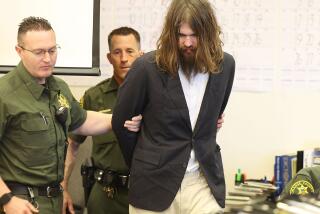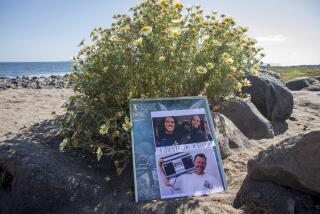Australian’s slaying stirs speculation in Oklahoma
DUNCAN, Okla. — Even before his name became known worldwide — before authorities said he and two other boys killed an Australian college student because they were “bored” — the boy known as “Bug” had changed.
His sister saw it; so did family friends: His American Eagle clothes and sweet demeanor were replaced about six months ago by drooping pants, the do-rags, and a vile stream of braggadocio, sexism and racism the 15-year-old unleashed over his social media accounts.
In an Oklahoma town of about 23,000 that was 82% white, Bug, who is black, sometimes tweeted things like “90% of white ppl are nasty. #HATE THEM.”
A female member of Faith Church in Duncan recalled later that he’d told her, “I can’t go to your church anymore because my god is black.”
“I don’t understand. God, I wish I could have just got to him,” Danielle Crudup, 20, said of her little brother, whose full name is James Francis Edwards Jr. “I tried to talk and talk and talk to him, and it just seemed like he wouldn’t listen.”
Still, she said, “I’d never in a million years expect that he’d be sitting in jail on a murder charge.”
Authorities have not tied race to the killing of Christopher Lane, a strapping young athlete from Melbourne attending East Central University in Ada, Okla., about 80 miles away. Lane was out for a jog Friday when he was shot once in the back by a gunman in a passing car.
Authorities say one of the boys said they targeted Lane, who is white, because they were bored and had nothing to do.
Edwards and Chancey Allen Luna, 16, who is also black, were charged with first-degree murder. At the police station, Edwards danced while they were booking him, said Duncan Police Chief Daniel P. Ford. “He thought it was cool,” Ford said.
Michael Dewayne Jones, 17, who is white, was charged with lesser counts — accessory to the murder and use of a vehicle in discharge of weapon. According to court documents, Jones was the driver and told police he knew who shot Lane but was worried he’d “get killed” if he snitched.
With what appears to have been a single pull of the trigger, the southern Oklahoma town of Duncan has been heaved into a cultural and political vortex, one that has Australians making threats about boycotting U.S. tourism while residents loudly defend their gun rights and quietly talk about race and the changing way of life in their state.
Duncan is a town that has seen the ups and downs of oil booms, as well as the prolonged invasion of drug use that has crept through the rest of middle America. “This town is a town where it’s drugs or Jesus,” said Cole Hamer, 20. “You either got the drugs, or you got the churchgoers, and that’s what it is.”
The killing also has laid bare divisions in this town. The three alleged assailants came from what is known as the gritty part of town; a prosecutor called them “thugs.” Lane had been visiting his girlfriend’s family in Duncan’s north end, a prim neighborhood with brick homes and big yards.
After he was shot, Lane tumbled into a ditch. Blood covered the back of his gray shirt. The 23-year-old exchange student, a catcher on his university baseball team, turned blue and stopped breathing as onlookers gave him CPR.
“If you don’t hurry, he’s gone,” one woman told a 911 dispatcher, as she anxiously watched the horizon for emergency lights.
The lights wouldn’t arrive soon enough. Lane was soon pronounced dead at a local hospital.
Any shooting is a shock in Duncan, which can go years without seeing a slaying. “If you’d have told me a week ago there was a gang in Duncan, I’d have chuckled,” said Mark Morrow, a youth pastor at Faith Church who has known Edwards since he was a boy. “There are a lot more rednecks than gangs.”
At Wright’s Donuts on Old U.S. Highway 81 in Duncan early Wednesday, the talk over breakfast was over one thing: the shooting. There were soft-spoken questions about why the killing had to happen here and comments that race will inevitably be brought up, whether it was a factor in the shootings or not. (Luna once featured a “Black power” banner on his Facebook profile.)
At the doughnut shop — which is across the street from a firearms training facility with a sign that says, “Got gun?” — Brandon Arrington, 31, and Christian Perez, 23, took a table near the door with doughnuts and plastic containers of milk. Both were born and raised in Duncan.
“Used to be, you could leave your doors unlocked, leave your truck unlocked,” said Arrington, who was wearing a camouflage hat and work jeans. Those days are gone, at least in town, he said. He lives in the country.
He and Perez read over the local newspaper splashed with the teenagers’ mug shots, shaking their heads. “Those guys are the reason people will lock up their guns,” Perez said.
In the car allegedly used in the killing, police found a shotgun hidden beneath the spare tire in the trunk and .22-round ammo hidden inside the car’s fuse box and beneath the engine’s cold-air conductor, according to court documents. A single .22-caliber casing was found beneath a back seat cushion.
And now the questions mount: How could these kids go so wrong? What happened?
Ford has looked at Edwards’ social media feeds and their racist comments. “Sometimes that’s a motivation; sometimes it’s an attention-getter,” he said. “You can say anything you want on Facebook.”
Crudup, Edwards’ sister, has seen the comments on social media too and cannot reconcile the brother she knows with “all that stuff on his Facebook — all that gangbanging.”
“This is not who he is,” she said.
Since the shooting, people have flooded Edwards’ public Facebook page with comments. Some people denounce him as a racist, some leave their own racist comments, and others argue about guns and gun control.
Ford says he’s been asked over and over by Australian officials and media why guns are so widely allowed, and he’s been frustrated by it.
“These punk kids are going to take our freedom away? Give me a break,” said Ford, who has sketches and photos of John Wayne in his office. “Why would we let three thugs do that?”
At the place where Lane fell, George Schwartz, 60, who lives nearby, wiped his brow in triple-degree heat Wednesday as he walked up to an impromptu memorial — flowers, a photo of Lane and an Australian flag.
“Somebody beat me to it,” he said to the others gathered at the site, looking at a thick wooden cross with Lane’s name carved into it that had been planted in the ground. “I was going to put a cross there.”
Branson-Potts reported from Duncan, Okla., and Pearce from Los Angeles.
More to Read
Sign up for Essential California
The most important California stories and recommendations in your inbox every morning.
You may occasionally receive promotional content from the Los Angeles Times.












